You are legally required to tell the DVLA when you sell your car, but many people find the process of transferring ownership confusing.
Ready to sell your car? You can transfer ownership online or by post. However, in most cases, it’s much quicker and simpler to make the transfer online. In this article, we’ll guide you through the processes for transferring ownership, whether you’re selling your car privately or to a motor trader.
Quick links:
Get a free valuation
V5C logbook and transferring ownership explained
A V5C logbook (also known as a ‘vehicle registration document’ or ‘logbook’) is issued by the DVLA when a car is registered with them. This document plays a crucial role in the ownership transfer process.
Here are a few key points concerning the V5C logbook and transferring ownership:
The V5C reference number
- You’ll need the unique 11-digit reference number found in your V5C logbook when transferring online.
- You’ll need to complete the relevant sections of your V5C logbook when transferring by post, but this isn’t necessary if you complete the transfer online. (The process is completely digital.)
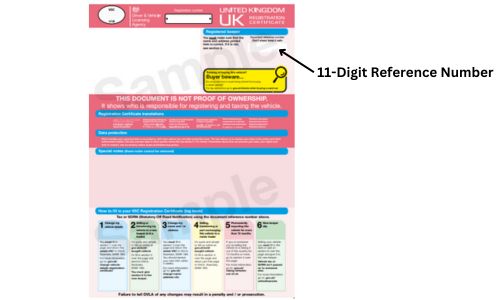
You can find your document reference number on the front cover of your V5C logbook.
Old vs. new-style V5C logbooks
There are two styles of V5C logbook in circulation. You’ll have the new-style logbook if it was issued from 15th April 2019 onwards – or the old style if it was issued prior to that.
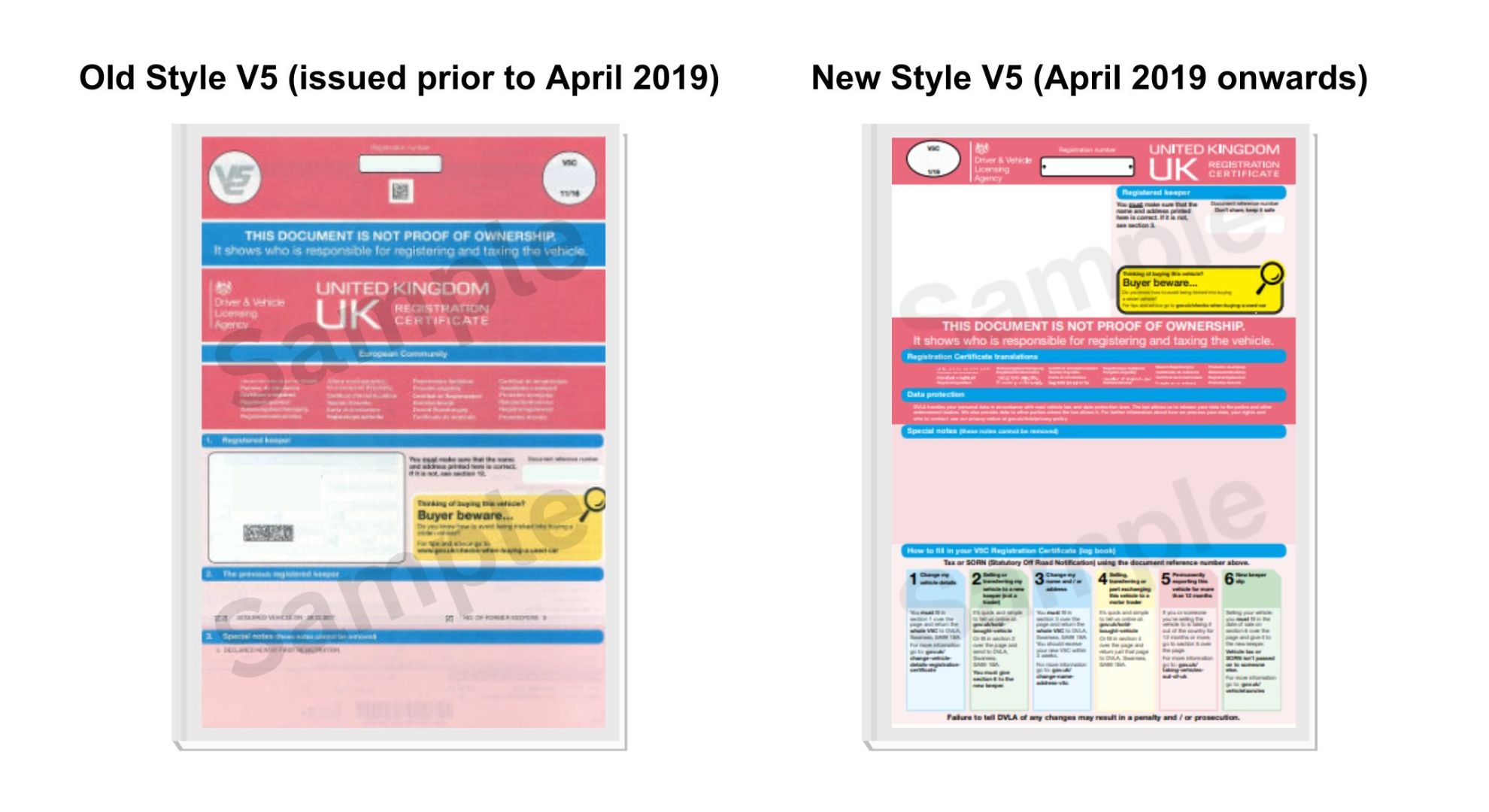
Front cover for both versions of a V5C logbook.
What happens when your car’s owner changes?
Each time a car’s owner changes, the DVLA will issue a fresh V5C logbook in the new keeper’s name.
Selling without a V5 logbook
Although it is technically possible to sell your car without a V5C logbook, many buyers will be deterred if this document is missing. Unfortunately, webuyanycar can’t buy your vehicle without a V5C logbook.
Please note: If you require DOC (car insurance to drive other cars), you should contact your car insurance provider (or log in to your account to see whether this option is available).
Who should complete the V5C logbook?
Whether you’re transferring online or by post, the responsibility to notify the DVLA of the change of ownership lies with the vehicle’s registered keeper.
If you are transferring car ownership online, you don’t need to complete the V5C logbook at all. You just need to enter the 11-digit reference number from the logbook during the online transfer process.
However, if you are transferring by post, as the outgoing keeper, you must fill in the V5C logbook with the new keeper’s details.
This will ensure you are not held legally responsible for a vehicle you no longer own.
Transferring car ownership online (step-by-step)
In this section, we’ll explain the easiest process of transferring ownership online.
Transferring ownership to a private buyer
- Make sure you have the 11-digit reference number from your car’s V5C logbook and the new owner’s personal details to hand.
- Head to the gov.uk website and visit the ‘Tell the DVLA you’ve sold, transferred, or bought a vehicle’ page.
- Answer the questions given. You can include the new owner’s email address on the form so that they’ll receive confirmation. Submit the form and you’ll receive an email confirmation.
- The new owner should receive a fresh physical copy of the V5C logbook containing their details within five working days.
Transferring ownership to a motor trader or scrap yard
- Visit the DVLA website and tell them you’ve sold your car into the motor trade by answering the questions on screen.
- Detach the yellow segment from your V5C logbook – and destroy it.*
- Give the remainder of the logbook to the motor trader.
*This is section 4 in V5C logbooks issued from 15th April 2019 – and section 9 in the old-style logbooks issued prior to 15th April 2019.
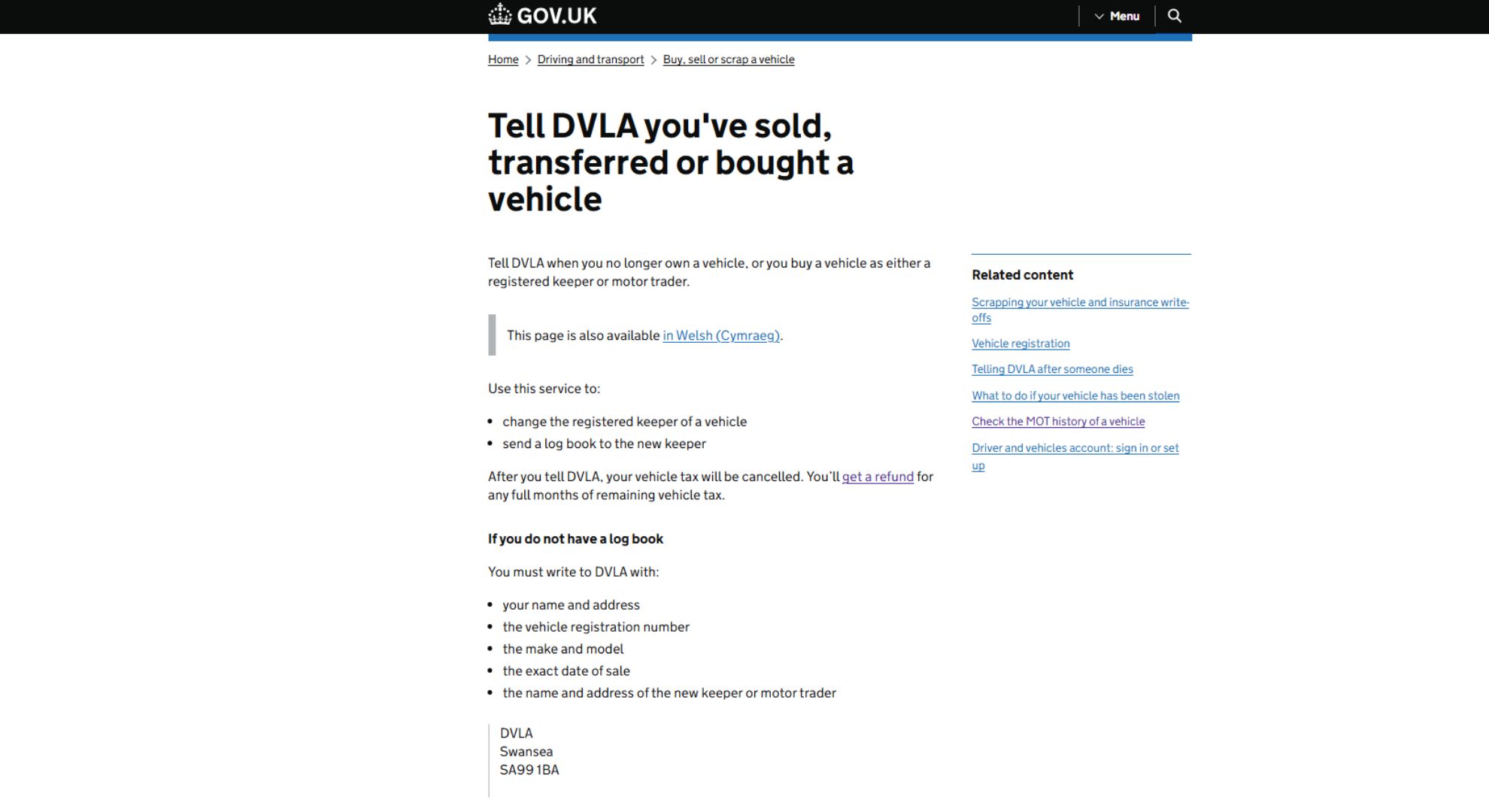
Updating online is the simplest way. You can follow the instructions on the UK Government website.
Transferring car ownership by post (step-by-step)
In this section, we’ll explain the processes for each type of postal transfer.
Transferring ownership to a private buyer
For the latest V5C logbook format (issued from April 2019 onwards).
- Complete section 2 of your V5C logbook with the new owner’s name and address.
- Write the date of the sale in section 6 and give the new keeper slip to the buyer.
- Post the remainder of the V5C logbook to the following address: DVLA, Swansea, SA99 1BA.
For old style V5C logbooks (issued prior to April 2019).
- Make sure you have the details of your vehicle, the sale, and the new owner to hand.
- Fill out section 6 of your V5C logbook, ensuring all details are correct.
- You and the new keeper must sign and date the declaration in section 8.
- Detach section 10 (also known as the ‘new keeper slip’) and give it to the buyer.
- Detach sections 1-8 of your V5C logbook, then post the paperwork to the following address: DVLA, Swansea, SA99 1BA.
Transferring ownership to a motor trader or scrap yard
For the latest V5C logbook format (issued from April 2019 onwards).
- Complete section 4 of your V5C logbook with the motor trader’s name and address.
- Detach the whole perforated section and post it to: SA99 1BA.
- Give the remainder of the V5C logbook to the motor trader.
For old style V5C logbooks (issued prior to April 2019).
- Complete section 9 of the V5C logbook.
- Detach the section and post it to: DVLA, Swansea, SA99 1BA. (Do not give this section to the motor trader.)
- Give the remainder of the V5C logbook to the motor trader.
Please note: If you’ve given the full V5C logbook to the motor trader, write a letter to the DVLA with the following details to confirm the sale:
- Your name and address.
- The vehicle’s registration number.
- The make and model.
- The date of the sale.
- The name and address of the motor trader.
Post the letter to: DVLA, Swansea, SA99 1BA.
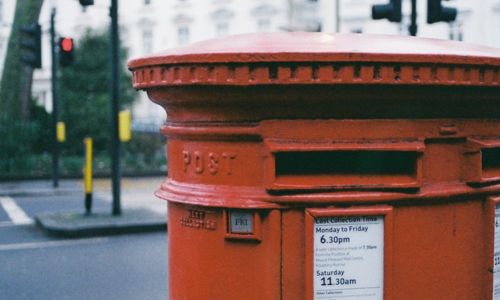
You can transfer ownership by completing the V5C sections, posting to DVLA, Swansea, SA99 1BA, and giving the slip to the buyer or trader.
How do I transfer car ownership to a family member?
The process for transferring car ownership to a family member is the same as if you were selling to a private individual, even if you are ‘gifting’ the car to the family member:
- The quickest way to transfer ownership to a family member is via the DVLA’s online service.
- Select ‘sold it’, for step 2, even if no money changed hands – and provide the 11-digit reference number in your V5C - and the new owner’s name and address when prompted.
- Alternatively, follow the relevant process for transferring ownership after a private sale by post (i.e. with an old or new-style V5C logbook). Just bear in mind that this option will take longer.

How to check whether you’re the registered keeper or legal owner
- The person responsible for transferring ownership is the registered keeper named in the V5C logbook.
- However, only the legal owner has the right to sell the car. If you want to sell a car on behalf of someone else, you’ll need their written permission.
It’s important to know the difference between the titles ‘registered keeper’ and ‘legal owner’, as they’re not always held by the same person – and carry different responsibilities. In this section, we’ll explain how to identify whether you’re the registered keeper, owner, or both:
Registered keeper
- Put simply, the registered keeper is the main user of the car. They are the person responsible for looking after the vehicle and paying for its road tax, MOT and other services.
- The registered keeper is the person named in the V5C logbook and other legal documents for the car.
- They are also responsible for making sure the vehicle is insured – even when it is being driven by someone else.
- Any parking fines, speeding violations or queries about traffic accidents associated with the vehicle will be sent to the person named as the registered keeper.
- The registered keeper is the person responsible for transferring ownership when the car is sold or gifted to someone else.
Legal owner
- The owner is the person who bought the car (or was gifted the vehicle).
- The owner must make sure that all paperwork for the vehicle (including the V5C logbook) is kept up to date with the registered keeper’s current details.
- When they have bought a car (or it is gifted to them), the owner should retain a receipt with details of the car and the transaction so that they can prove their ownership.
- The owner is responsible for making sure that anyone they allow to drive the car is insured to do so (e.g. a prospective buyer test driving the vehicle).
If you’re not sure whether you are a vehicle’s owner or registered keeper, you can request this information via a V888 form, which you can submit via the gov.uk website or by post.
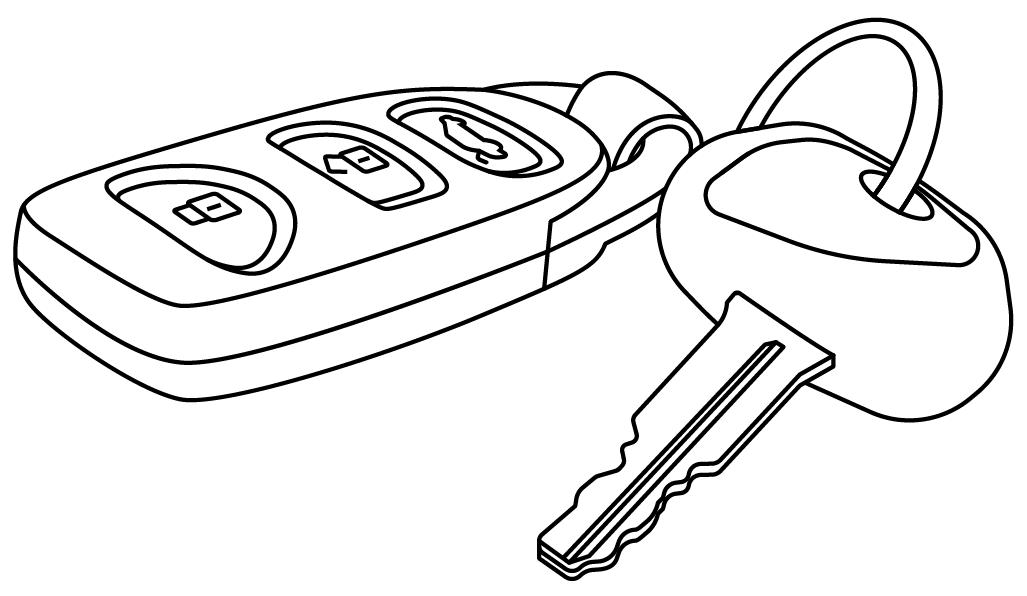
Are the owner and the registered keeper the same person?
One person will often be named as both the owner and the registered keeper of a vehicle - but not always. In some cases, these titles will be held by two different people. For example:
- The employee regularly using a company car will be named as its registered keeper. However, the company employing them will be named as the owner.
- If you are leasing a car through a Personal Contract Hire (PCH) plan, you will be named as the registered keeper, whilst the car leasing company will be named as the owner.
Retaining a private reg when selling your car
If you want to retain your private reg, you’ll need to take the plate off the car before you sell it. Otherwise, you’ll lose the right to use that registration, as it will be transferred to the new owner at the point of sale.

Mistakes to avoid when transferring car ownership
-
If you’re transferring car ownership online, don’t forget to make a note of the 11-digit V5C reference number.
-
Don’t give the full V5C logbook to a buyer or motor trader. Read the instructions above carefully.
-
After transferring ownership to a motor trader online, don’t forget to remove and destroy the yellow section of your V5C logbook (section 4 for the new-style logbooks - and section 9 for the old-style logbooks). Then, give the remainder of the V5C logbook to the motor trader.
-
If you have given the full V5C logbook to a buyer or trader, you’ll need to write to the DVLA to inform them of the sale. Don’t rely on the dealer to update them.
-
As the registered keeper, it’s always your responsibility to notify the DVLA that your car’s owner has changed.
-
If you fail to update the DVLA, you could receive a fine of up to £1,000 – and you may be held liable for any motoring offences and penalties accrued by the new owner.
-
If you have a private registration that you want to keep, you’ll need to take the plate off your car before selling it.
-
After transferring ownership, don’t forget to cancel your insurance – or transfer your policy to your new car.
Frequently Asked Questions
Ownership of a vehicle can only be transferred by its registered keeper. You should only transfer ownership if you intend to sell or give your car to another individual, car dealer or scrapyard.
A UK-registered car can technically only have one registered keeper.
However, while the DVLA intended the process to be limited to just one keeper, there is currently no validation in place for a vehicle’s registered keeper. Therefore, it is entirely possible for a single vehicle to be registered to multiple individuals if all the relevant names are listed. For example, a small business’ vehicle may be registered to all its directors in this manner.
No, you cannot transfer unused road tax to the new owner. You should notify the DVLA immediately once you have sold your car, so that you can receive a refund for any full months’ unused road tax.
You can request details of the registered keeper of a vehicle (i.e. the person who is legally responsible for the car) from the DVLA by completing a V888 form. When filling out the form, you must state a ‘reasonable cause’ for requiring this information.
There is currently no limit to how many vehicles an individual can own in the UK.
If you fail to notify the DVLA when changing the owner of your car, you may receive a fine of £55 (reduced to £35 if paid within 17 days). If you fail to pay within this timeframe, the case may be processed by a magistrates’ court – and you could receive a penalty of up to £1,000.


